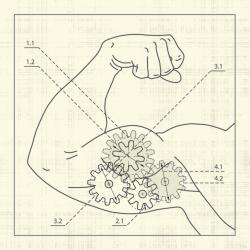Strength Training Exercise for Upper Body Muscle Groups
If you are just starting to get into strength training, be sure your routines are balanced by targeting both upper and lower body muscles. In the upper body, be sure to include exercises that work the:
- biceps
- triceps
- shoulders
- chest
- back
The Biceps
- One of the most popular exercises for biceps is the curl:
- To begin, stand with your feet shoulder-width apart.
- Hold the weight with palms facing up, elbows in next to your body.
- Now (without moving them) bend at the elbows and bring the weight up and toward your body.
- Now slowly lower the weight back down to the starting position.
- The curl can be done with either a weighted barbell or with dumbbells.
The Triceps
The dip does not require any exercise equipment making it a great exercise to do when traveling. To start:
- Sit on a chair.
- Put your hands on the front edge of the chair seat.
- While supporting your weight with your hands and arms, move to the edge of the chair so the rest of your body is just off the edge of the chair
- Bend the elbows (no lower than 90 degrees) and lower your body down, keeping very close to the chair.
- Finish the exercise by pushing your body back up without locking the elbows.
The Shoulders
The overhead press targets the deltoids in the shoulder.
- Start by standing (or sitting) holding a weighted barbell with your elbows bent and hands at eye level.
- Push the barbell straight up until your arms are fully extended without arching your back.
- Lower the barbell back to the starting position.
The Chest
The basic press targets the major muscles of the chest, along with shoulder and triceps. To do the basic press:
- Lie on a weight bench with a weighted barbell over your chest, elbows bent at 90-degree angle.
- With your arms, press the barbell straight up.
- Lower back to starting position.
The Back
Rows are a great exercise to strengthen the muscles in your back. To start:
- With dumbbells in each hand, bend over at the waist until you are looking straight down at the floor. Keep your abs pulled in and knees slightly bent.
- Let the weights hang straight down from your arms, without locking your elbows.
- Bend the elbows and pull the weights up until your elbows are level with your body.
- Lower the weights back down to the starting position.
Beginners should strive to perform 1 to 2 sets of each exercise with 12 to 16 repetitions per set. As your fitness level advances, you can work up to 2 to 3 sets with 8 to 12 repetitions per set.
You know you are using the right amount of weight if the last repetition in the last set is very hard, if not impossible, to do. You know you have then hit muscle failure.
Strength Training Exercise for Lower Body Muscle Groups
If you are just starting into strength training, be sure your routines are balanced by targeting both upper and lower body muscles. In the lower body, be sure to include exercises that include working the:
- quadriceps
- hamstrings
- abdominals
The Quadriceps
The squat is a great exercise to target the quadriceps (quads). To perform the basic squat:
- Stand with your feet shoulder-width apart.
- Bend at the knees and gently lower your body down until your thighs are parallel to the floor.
- Slowly raise your body back up to the starting position.
A variation of this is the assisted squat. The exercise is basically the same except you use a resistance band tied to a doorknob or stair rail to steady yourself. Put some resistance on the band by pulling it with both hands. Now perform the squat as usual.
The Hamstrings
The front lunge is a basic lower body exercise that works the hamstrings. To begin, stand with your feet shoulder-width apart. Now:
- With your left leg, step forward and lower your body until your thigh is parallel to the floor.
- Now with that same leg, push yourself back to the starting position.
- Either repeat with this same leg for the desired number of repetitions or use your right leg and alternate between legs until reaching your target number of reps.
- To work your hamstrings even more hold a dumbbell in each hand.
A variation of the forward lunge is the reverse lunge. The exercise is basically the same except instead of lunging forward, your move your leg backwards.
The Abdominals
A simple, but very effective exercise that targets your abdominal core is the bicycle.
- To begin, lie on the floor with your hands locked behind your head and bring your knees to your chest.
- Now lift your shoulders off the floor and straighten your left leg while rotating the upper body to bring the left elbow toward the right knee.
- Without lowering your upper body, switch sides, now bringing your right elbow toward your left knee.
- Continue this back and forth oscillation until you have reached your desired number of reps.
- Lower your upper body and legs back down to the floor between sets for a short rest.
If you are just starting out, your goal should be to perform 1 to 2 sets of each exercise with 12 to 16 repetitions per set. As your muscles develop, you can work up to 2 to 3 sets with 8 to 12 repetitions per set.
The great thing about these lower body exercises is that none of them require any equipment, so you can do them anywhere, making them great exercises to do while away from home. When you return home, you can mix up your workout routine and do your strength training exercises for your upper body muscle groups using weights and resistance.









